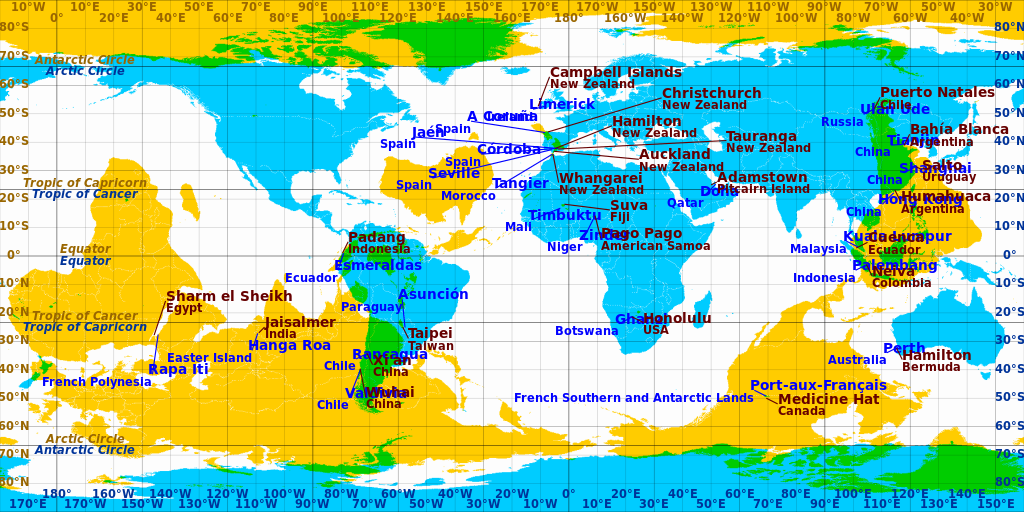I’ve been experiencing an ongoing conundrum. I have a huge pile of potential topics to cover on Twelve Mile Circle but I never get around to using them. I seem to get diverted onto whatever topic happens to be on hand and I forget about those I’ve held in reserve. Occasionally I’ll take a look and somehow find excuses to tell myself, “not this time”. And the spreadsheet continues to grow.
So a little pruning is in order. First I dumped a bunch of topics I figured I’d never cover. Maybe they would take too long to research; or maybe they didn’t have enough material to fill an entire article or maybe they were just plain stupid. I assigned a number to those that remained and used a random number generator to pick a value. That determined today’s topic. Now I think I might do this once a week until I get the reserve list into reasonable order again.
The website selected Random Number 51 which means I’ll try to figure out “cities or towns with the same name that are located farthest apart.”
Let’s Start
I’ll begin by examining the concept of farthest apart. For this I’ll need to find antipodes, those place on the globe that are exactly opposite of each other. These result in great circle distances of just about 20,000 kilometres, give-or-take. So my goal will be to find places that share the same name with a minimum separation approaching 20,000 km as closely as possible. This limits the possibilities considerably. There aren’t very many places on earth where both ends of an antipode fall on dry land.

It’s easy to narrow-down some possibilities. I figured there wouldn’t be much of an overlap in town names between China/Mongolia and Chile/Argentina, as an example. So I didn’t bother to look. I did note my earlier article that “Taiwan used to be called Formosa. The antipode for one small corner of the island falls in Argentina, in the province of Formosa.” However, it doesn’t apply here because I’m looking for two cities or towns, not a former national name and a province.
Combing Through the British Empire
I saw a few possibilities pretty quickly. I focused my energy using the maxim, “the sun never sets on the British Empire”. Also I speculated that there could perhaps be some synergy between Spanish names used in the Philippines and Portuguese names used in Brazil, or a potential Dutch connection between Suriname and the Dutch East Indies. Those are for you to explore. I focused on spheres of British influence.
New Zealand is close to being antipodal to the United Kingdom. Western Australia does the same with the eastern United States and various British-settled islands of the Caribbean. Those seemed like better bets.
New Zealand
The Encyclopedia of New Zealand didn’t offer much hope: “Direct borrowing of United Kingdom place names was uncommon.” Uncommon didn’t mean impossible though, so I weeded through their examples and dumped them into a great circle distance calculator.
- Roxburgh, New Zealand to Roxburgh, Scotland = 18,750 km.
- Belfast, New Zealand to Belfast, Northern Ireland = 18,760 km.
- Oxford, New Zealand to Oxford, England = 18,946 km.
I did search briefly for place names in New Zealand that seemed to have a Spanish influence without any luck.
Australia
Then I figured I could do better by turning my attention to Australia. There I struck gold.
- Bridgetown, Western Australia to Bridgetown, Barbados = 17,655 km.
- West End, Western Australia to West End, Bahamas = 18,672 km.
- Cane, Western Australia to Cane, U.S. Virgin Islands = 19,524 km.
I know what you’re thinking. I’m cheating, right? A place called Cane in the U.S. Virgin Islands doesn’t even appear on Google Maps. Nonetheless it is a real place and I confirmed that it’s included in the US Geological Survey’s Geographic Names Information System. Maybe some enterprising reader could try another version of this game where the towns have to be home to more than 10,000 (or 100,000) residents.
I’m not saying 19,524 km is the farthest distance between two towns with the same name, just that it comes very close to the theoretical maximum. I’d be thrilled if someone could improve upon this result.

Leave a Reply